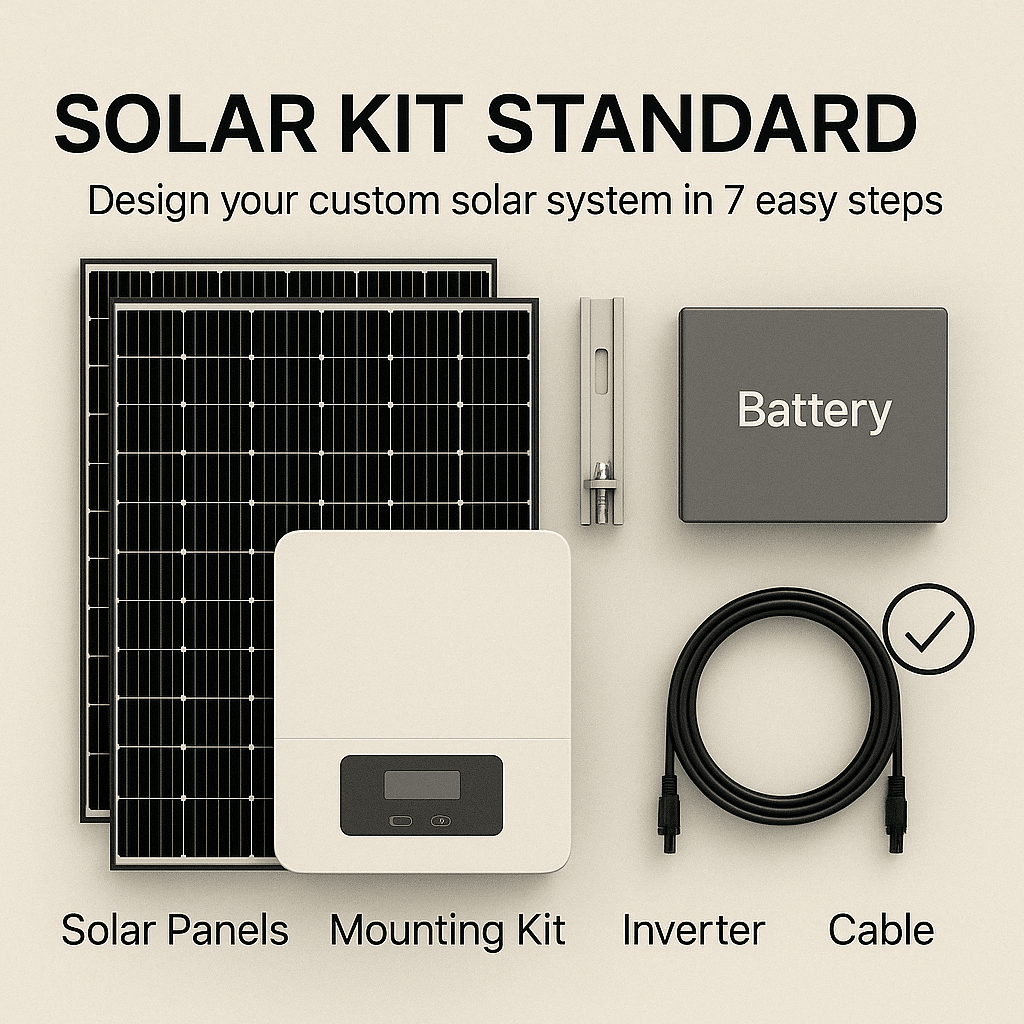📦 Fast Delivery – Order Now!
💸 Shop Safely – 100% Money-Back Guarantee
👨🔧 Lifetime Customer Support
📦 Fast Delivery – Order Now!
💸 Shop Safely – 100% Money-Back Guarantee
👨🔧 Lifetime Customer Support
The idea of powering your home with sunshine is exciting – slashing electricity bills, reducing your carbon footprint, and gaining energy independence. But as you start to explore solar, one of the first and most critical questions that comes up is: “How do I calculate how many solar panels I need?” It’s a common question, and getting the answer right is key to a successful solar installation.
You don’t want too few panels, leaving you still reliant on the grid and paying high electricity bills. And you definitely don’t want too many, leading to unnecessary upfront costs and wasted space. The good news is, figuring out your home’s ideal solar setup is more straightforward than you might think. Let’s break it down into easy, actionable steps.
Understanding how to calculate how many solar panels you need isn’t just about avoiding a guessing game; it directly impacts your return on investment; it directly impacts your return on investment and energy savings. An accurately sized system ensures you generate enough power to meet your needs, maximize your savings, and potentially even sell excess electricity back to the grid (if net metering is available in your area). It’s all about optimizing your system for efficiency and the best possible long-term benefits.
To know how much power you need to generate, you first need to know how much power you’re currently using.
The best place to find this information is your electricity bill. Look for your usage measured in kilowatt-hours (kWh). Most bills will show your monthly kWh consumption.
To get the most accurate picture, try to look at your annual energy usage. Energy consumption can vary significantly throughout the year – you might use more electricity for AC in the summer or heating in the winter. Averaging at least 12 months of bills will give you a comprehensive understanding of your typical energy patterns. Divide your annual kWh by 365 to get your average daily kWh consumption.
Pro Tip: Think about your future. Are you planning to buy an electric vehicle, add a new air conditioning unit, or expand your family? These changes will likely increase your energy needs, and it’s smart to factor them into your calculations now.
Not all roofs are created equal when it comes to solar power. Several factors influence how much sunlight your panels will receive:
Solar panels come in various sizes and power outputs. These specifications play a direct role in how many panels you’ll need.
With your energy consumption and roof potential in mind, it’s time to apply the formula to answer the questions: How do I calculate how many solar panels I need?
Here’s the basic formula to estimate how many solar panels you need:
Number of Panels = (Your Average Daily kWh Needed) / (Panel Wattage in kW * Peak Sun Hours * Derating Factor)
Let’s break down each part and work through an example:
Now, let’s calculate using our example numbers:
Number of Panels = 30 kWh / (0.4 kW * 4.5 hours * 0.8) Number of Panels = 30 kWh / (1.44 kWh) Number of Panels ≈ 20.83
So, in this example, you’d need approximately 21 solar panels. Remember, this is an estimate; slight rounding up may be necessary.
While the math helps you calculate how many solar panels you need, several other practical factors can influence your final system size:

“How do I calculate how many solar panels I need?” is just the first step. The next is finding a solution that makes going solar straightforward and stress-free. That’s exactly where our Solar Kits come in!
We’ve simplified the entire process, allowing you to design your own complete solar energy system in just a few easy steps. Whether you’re a seasoned DIY enthusiast or new to solar, our kits provide everything you need. Here’s what makes them stand out:
Take the guesswork out of going solar. Our Solar Kits empower you to create a customized, high-performing solar energy system tailored to your home.

🔆 Standard Solar Kit – Your Custom Solar System in 7 Guided Steps
Design your solar setup with full flexibility and pre-configured mounting: choose solar panels, inverter, battery, mounting kit, wiring essentials, combiner, and accessories – all step by step and fully compatible.
✅ Includes mounting material from K2 Systems for standard layouts
✅ Choose only the components you need
✅ DIY-friendly and pre-checked for compatibility
✅ 🎁 Battery discount included when bundled
Calculating “how many solar panels do I need?” involves understanding your home’s energy consumption, assessing your roof’s unique potential, and knowing a bit about solar panel specifications. By following these steps and exploring our easy-to-assemble Solar Kits, you’re well on your way to making an informed decision for a powerful, efficient, and sustainable future. Take control of your energy, harness the sun, and enjoy the many benefits of going solar!

Your electricity bill is the most accurate starting point because it shows your actual energy consumption in kilowatt-hours (kWh). Looking at at least 12 months of bills is crucial to capture seasonal variations (e.g., more AC use in summer, heating in winter), providing a comprehensive average for your household’s energy demand.
It’s highly recommended to consider future energy needs when calculating your solar panel requirements. If you plan to add an electric vehicle (EV), install a new air conditioning unit, or expand your household, these additions will increase your electricity usage. Factoring these potential increases into your initial calculations can prevent the need for costly system expansions later on.
Yes, roof shading matters significantly. Even partial shading on a few panels can drastically reduce the overall output of your entire solar array. Trees, neighboring buildings, or even chimneys and vents can cast shadows throughout the day. Professional solar planning tools can map out shading patterns accurately, but for your initial calculation, identify any major, persistent shadows.
Peak sun hours (or full sun hours) refer to the average number of hours per day when the intensity of sunlight is sufficient to generate approximately 1,000 watts of power per square meter. This is not the same as daylight hours. For example, a location might have 12 hours of daylight, but only 4-5 peak sun hours. This metric is vital for accurately estimating your solar panel’s daily energy production.
The derating factor is a multiplier (typically between 0.75 and 0.85) used in solar calculations to account for real-world inefficiencies and losses that prevent solar panels from producing their nameplate (rated) wattage all the time. These losses can come from factors like temperature, dirt/dust on panels, wiring resistance, and inverter efficiency. Using a derating factor ensures your calculation reflects a more realistic energy output.
Most common residential roof types, including asphalt shingles, metal, and tile, are suitable for solar panel installation. However, the specific mounting hardware will vary depending on your roof material and structure. Our Solar Kits are designed to include the appropriate mounting materials for different roof types, ensuring compatibility.
Our Solar Kits take the guesswork out of sizing and compatibility. Once you have an idea of your energy needs (using the calculation methods in this guide), you can select a kit that aligns with that output. Each kit is a complete package, including panels, inverters, and all necessary mounting hardware. All components are pre-selected to be fully compatible, ensuring an easy and efficient self-assembly process.
Yes, installing solar panels generally increases a home’s value. Studies have shown that homes with solar energy systems sell for more and often sell faster than comparable homes without solar, especially when the system is owned outright. The value comes from the reduced electricity costs and the appeal of sustainable living.
While our guide provides the formula, many online tools and apps can help you estimate your solar needs more precisely, often using satellite imagery and local weather data. Websites from government energy departments or solar industry associations often offer such calculators. However, remember these are estimates; a professional assessment or using a pre-configured kit is the most reliable way to finalize your system.
The “20% rule” in solar panel calculations is a general guideline, not a strict rule, that suggests designing your system to produce roughly 20% more energy than your current consumption. This buffer helps account for future increases in energy use, potential minor panel degradation over time, and variations in weather patterns that might slightly reduce output. It ensures you remain adequately covered and maximize your potential savings.
Understanding your energy consumption is key to determining the number of panels you require. This table provides a quick reference for common daily energy consumption levels and the approximate number of 400W solar panels typically needed to meet those needs, assuming 4.5 peak sun hours and an 80% derating factor.
This is a simplified estimation; actual requirements may vary based on your specific location, roof characteristics, and panel efficiency.
| Average Daily Energy Consumption (kWh) | Estimated Number of 400W Solar Panels Needed | Approx. System Size (kW) |
|---|---|---|
| 10 kWh | 7 – 8 panels | 2.8 – 3.2 kW |
| 20 kWh | 14 – 15 panels | 5.6 – 6.0 kW |
| 30 kWh | 21 – 22 panels | 8.4 – 8.8 kW |
| 40 kWh | 28 – 29 panels | 11.2 – 11.6 kW |
| 50 kWh | 35 – 36 panels | 14.0 – 14.4 kW |
AceFlex is one of the leading online retailers of renewable energy products and offers a wide range of solar products. We work with well-known manufacturers and wholesalers and can offer you cost-effective products in the field of photovoltaics so that you too can contribute to the energy transition.
Looking for an experienced team for planning your photovoltaic system without the hassle of doing it yourself? We are your trusted partner, offering comprehensive nationwide solutions. We provide expert consultation and supply of both photovoltaic systems and storage units tailored to your specific needs.
© 2025 Aceflex All Rights Reserved. Design by Media Pantheon, Inc.